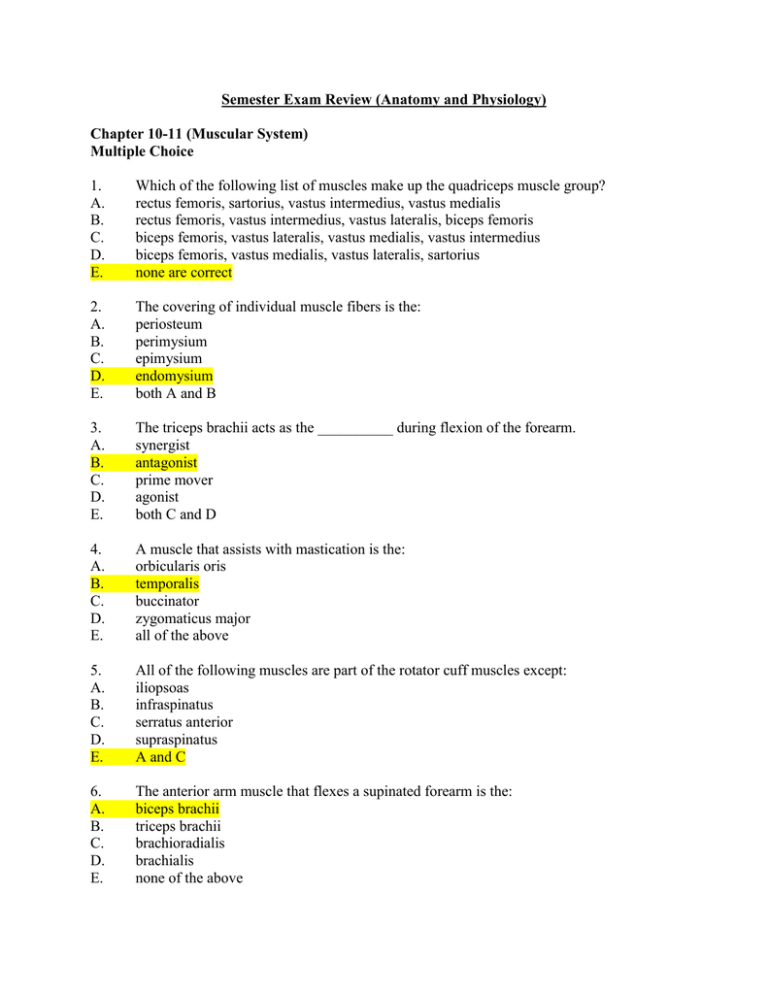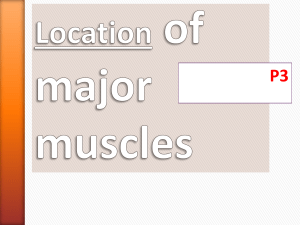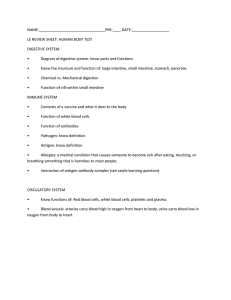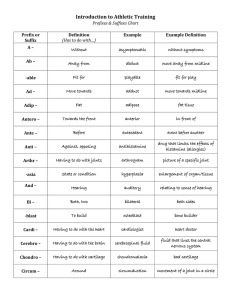Semester Exam Review (Anatomy and Physiology) Chapter 10
advertisement

Semester Exam Review (Anatomy and Physiology) Chapter 10-11 (Muscular System) Multiple Choice 1. A. B. C. D. E. Which of the following list of muscles make up the quadriceps muscle group? rectus femoris, sartorius, vastus intermedius, vastus medialis rectus femoris, vastus intermedius, vastus lateralis, biceps femoris biceps femoris, vastus lateralis, vastus medialis, vastus intermedius biceps femoris, vastus medialis, vastus lateralis, sartorius none are correct 2. A. B. C. D. E. The covering of individual muscle fibers is the: periosteum perimysium epimysium endomysium both A and B 3. A. B. C. D. E. The triceps brachii acts as the __________ during flexion of the forearm. synergist antagonist prime mover agonist both C and D 4. A. B. C. D. E. A muscle that assists with mastication is the: orbicularis oris temporalis buccinator zygomaticus major all of the above 5. A. B. C. D. E. All of the following muscles are part of the rotator cuff muscles except: iliopsoas infraspinatus serratus anterior supraspinatus A and C 6. A. B. C. D. E. The anterior arm muscle that flexes a supinated forearm is the: biceps brachii triceps brachii brachioradialis brachialis none of the above 7. A. B. C. D. E. A muscle contraction in which there is movement of the muscle while the tension remains unchanged is known as: concentric contraction isometric contraction eccentric contraction isotonic contraction both B and D 8. A. B. C. D. E. The flexor muscles that move the fingers are located on the: anterior surface of the forearm posterior surface of the forearm posterior surface of the hand anterior surface of the brachial region none of the above 9. A. B. C. D. E. Which of the following is not a muscle of the quadriceps femoris group? rectus femoris vastus lateralis vastus medialis vastus intermedius all are quadricep muscles 10. A. B. C. D. E. A hamstring injury might affect which of the following muscles: rectus femoris sartorius gracilis gastrocnemius none of the above 11. A. B. C. D. E. A muscle is attached to the humerus and the ulna. When the muscle contracts, the elbow bends. That would mean that the: ulna attachment is the origin humerus attachment is the insertion neither attachment is the origin both attachments are the insertion none of the above 12. A. B. C. D. E. Which of the following muscles make up the hamstring muscle group? semitendinosus, semimembranosus, biceps femoris vastus lateralis, vastus medialis, vastus intermedius biceps femoris, rectus femoris, semitendinosus semitendinosus, semimembranosus, sartorius none of the above Chapter 12-14 (Nervous System) Multiple Choice 1. A. B. C. D. E. The part of the nervous system that transmits impulses from the CNS to the skeletal muscle is the: somatic nervous system autonomic nervous system central nervous system afferent division none of the above 2. A. B. C. D. E. Fascicles are held together by a connective tissue layer called the: endoneurium perineurium macroneurium epineurium none of the above 3. A. B. C. D. E. Which of the following is the deepest connective tissue layer of a nerve? endoneurium perineurium epineurium fascicle none of the above 4. A. B. C. D. E. The main divisions of the central nervous system are the: brain, spinal cord, and autonomic nerves brain, spinal cord, and peripheral nerves brain and spinal cord peripheral nerves, cranial nerves, spinal nerves none of the above 5. A. B. C. D. E. The brain has ______ major divisions. 4 5 6 7 none of the above 6. A. B. C. D. E. The vomiting reflex is mediated by the: cerebrum medulla thalamus cerebellum none of the above 7. A. B. C. D. E. 8. A. B. C. D. E. 9. The part of the brain that receives impulses from the labyrinth of the ear, and thus functions in the maintenance of equilibrium, is the: medulla pons cerebellum hypothalamus none of the above The part of the brain that can directly influence or inhibit the release of hormones from the pituitary is the: hypothalamus thalamus medulla cerebellum none of the above A. B. C. D. E. The part of the brain that can influence the release of hormones or the endocrine system is the: thalamus hypothalamus medulla pons none of the above 10. A. B. C. D. E. Somatic reflexes consist of: contractions of smooth muscle contractions of cardiac muscle glandular contractions contractions of skeletal muscles none of the above 11. A. B. C. D. E. Which of the following would not be an effector of the autonomic nervous system? skeletal muscles blood vessels sweat glands the iris of the eye none of the above 12. A. B. C. D. E. The peripheral nervous system includes: autonomic nerves sensory nerves somatic nerves all of the above none of the above 13. A. B. C. D. E. Which of the following is not a function of the central nervous system (CNS)? integrating sensory information evaluating the information initiating an outgoing response all of the above are functions none of the above 14. A. B. C. D. E. Along a neuron, the correct pathway for impulse conduction is: dendrite, axon, cell body, and receptor dendrite, cell body, and axon axon, cell body, and dendrite receptor, axon, and cell body none of the above 15. A. B. C. D. E. Dendrites conduct impulses: toward cell bodies away from cell bodies within cell bodies all of the above none of the above 16. A. B. C. D. E. Nerves that contain mostly afferent fibers are called: sensory nerves motor nerves mixed nerves Schwann nerves none of the above 17. A. B. C. D. E. The brainstem does not include the: pons medulla midbrain cerebellum none of the above Chapter 17-19 (Cardiovascular System) Multiple Choice 1 A. B. C. D. Which of the following can carry oxygen? thrombocyte. platelet . erythrocyte. leukocyte. 2 A. B. C. D. Erythropoiesis is the formation of: platelets. red blood cells. white blood cells. all of the above. 3 A. B. C. D. Many types of blood cells are produced in the: liver. red bone marrow. pancreas. spleen. 4 A. B. C. D. Which type of white blood cells plays a major role in immunity to infectious diseases? eosinophils. lymphocytes. basophils. monocytes. 5 A. B. C. D. Thrombocytes are used for: body defense. transport of glucose. blood clotting. transport of oxygen. 6 A. B. C. D. Type AB blood is considered to be the universal recipient because: it does not contain either anti-A or anti-B antibodies. both antigen A and antigen B are absent from the red blood cells. it does not contain the Rh antigen. B and C. 7 A. B. C. D. The major ingredient in hemoglobin that allows oxygen to be transported is: sodium. iron. zinc. copper. 8 A. B. C. D. A decrease in red blood cell numbers can result in: anemia. toxemia. leukemia. polycythemia. 9 A. B. C. D. Which of the following formed elements assist in coagulation? leukocytes. thrombocytes. monocytes. erythrocytes. 10 A. B. C. D. The function of blood is to: carry food to the cells. assist the body in temperature regulation. remove waste from the cells. all of the above. 11 A. B. C. D. The saclike structure around the heart is the: myocardium. endocardium. pericardium. epicardium. 12 A. B. C. D. Which of the following is another name for the visceral layer of the pericardium? epicardium. fibrous pericardium. myocardium. endocardium. 13 A. B. C. D. The thickest layer of tissue in the heart wall is the: epicardium. myocardium. endocardium. pericardium. 14 A. B. C. D. The muscular layer of the heart wall is the: pericardium. myocardium. endocardium. epicardium. 15 A. B. C. D. The internal layer of tissue in the heart is the: pericardium. myocardium. endocardium. epicardium. 16 A. B. C. D. The right atrioventricular valve is also called the: tricuspid. mitral. aortic. bicuspid. 17 A. B. C. D. Which of the following is not an atrioventricular valve? mitral. bicuspid. aortic. tricuspid. 18 A. B. C. D. The valve that guards the left atrioventricular orifice is called the: mitral valve. bicuspid valve. tricuspid valve. both A and B. 19 A. B. C. D. Which of the following is a semilunar valve? mitral. tricuspid. aortic. bicuspid. 20 A. B. C. D. The structural components of the circulatory system include the: heart and lymph nodes. heart and blood vessels. heart, vessels, and lymph nodes. heart and lungs. 21 A. B. C. D. The order of blood flow through the vessels is: arterioles, venules, capillaries, arteries, and veins. veins, venules, capillaries, arterioles, and arteries. arteries, arterioles, capillaries, venules, and veins. arterioles, arteries, capillaries, veins, and venules. 22 A. B. C. D. Which of the following vessels carries blood from the lungs to the heart? aorta pulmonary vein inferior vena cava pulmonary artery 23 A. B. C. D. Atrioventricular valves prevent backflow of blood into the: lungs. vena cava. atria. ventricles. 24 A. B. C. D. The ventricle of the heart that ejects blood toward the lungs is the: right ventricle. left atrium. left ventricle. right atrium. 25 A. B. C. D. Which of the following is a cuspid valve? aortic. mitral. pulmonary. A and B. Chapter 23 Test (Respiratory System) Multiple Choice 1. A. B. C. D. The total number of lobes in both lungs is: 6 5 4 3 2. A. B. C. D. The small openings in the cribriform plate function to: allow air to move between the nostrils allow branches of the olfactory nerve to enter the cranial cavity and reach the brain provide a filtering system for the inspired air A and B 3. Which of the following lists the correct sequence of air as it passes through the nose into the pharynx? vestibule—anterior nares—inferior, middle, and superior meati—posterior nares inferior, middle, and superior meati—nostrils—vestibule—posterior nares anterior nares—vestibule—inferior, middle, and superior meati—posterior nares anterior nares—posterior nares—vestibule—inferior, middle, and superior meati A. B. C. D. 4. A. B. C. D. Which of the following is true of the cribriform plate? It: separates the nasal and cranial cavities forms the lateral aspects of the nose separates the internal nose from the mouth forms a midline separation in the nasal cavity 5. A. B. C. D. The largest of the paranasal sinuses is the: maxillary frontal ethmoid sphenoid 6. A. B. C. D. The structures that deflect air as it passes through the nose are called: choanae paranasal sinuses conchae vibrissae 7. A. B. C. D. The structure known as the “Adam’s apple” located in the neck is the: epiglottis cricoid cartilage glottis thyroid cartilage 8. A. B. C. D. The more common name for the pharynx is the: throat windpipe voicebox nasal cavity 9. A. B. C. D. The eustachian tube connects the middle ear with the: trachea nose nasopharynx oropharynx 10. A. B. C. D. The smallest branches of the bronchial tree are: primary bronchi secondary bronchi tertiary bronchi bronchioles 11. A. B. C. D. Which of the following is not a subdivision of the thoracic cavity? left pleural division right pleural division medial pleural division mediastinum 12. A. B. C. D. Which of the following is not a true statement? When the diaphragm relaxes, it returns to a domelike shape When the diaphragm contracts, it pulls the floor of the thoracic cavity downward Changes in thorax size bring about inspiration and expiration Raising the ribs decreases the depth and width of the thorax 13. A. B. C. D. Gas exchange occurs in the: alveoli trachea alveolar ducts A and C 14. A. B. C. D. The length of the pharynx is about: 3.5 cm 8.5 cm 12.5 cm 17.5 cm 15. A. B. C. D. Which of the following is not part of the respiratory membrane? ciliated respiratory mucosa alveolar epithelium capillary epithelium all of the above are part of the respiratory membrane 16. A. B. C. D. Which of these is not an opening in the pharynx? trachea eustachian tube the fauces esophagus 17. A. B. C. D. Ciliated cells lining the respiratory tract: help move air into and out of the lungs trap and phagocytize microorganisms help move the mucus blanket toward the pharynx B and C 18. A. B. C. D. The lower border of the cavity of the larynx is formed by the: epiglottis cricoid cartilage glottis thyroid cartilage 19. A. B. C. D. The fauces, one of the seven openings found in the pharynx, opens into the: oropharynx nasopharynx esophagus A and B 20. A. B. C. D. Which of the following is not an accessory structure of the respiratory system? oral cavity trachea rib cage diaphragm 21. A. B. C. D. Olfactory epithelium is found: lining the nasopharynx covering the superior turbinate lining the paranasal sinuses all of the above 22. A. B. C. D. Which of the following is not a function of the pharynx? aids in forming vowel sounds pathway for food determines the quality of the voice pathway for air Chapter 25-26 Exam (The Digestive System) Multiple Choice 1. A. B. C. D. Structurally, enzymes are: lipids carbohydrates inorganic compounds proteins 2. A. B. C. D. The major site for the absorption of the end products of digestion is the: cecum large intestine stomach small intestine 3. A. B. C. D. Which of the following salivary glands produces only a mucous type of saliva? parotids sublinguals submandibulars A and B 4. A. B. C. D. The greatest proportion of the tooth shell consists of: enamel cementum dentin gingivae 5. A. B. C. D. Under normal conditions, how many deciduous teeth are there? 16 20 24 32 6. A. B. C. D. The walls of the GI tract are composed of ______ layers of tissue. five four three two 7. A. B. C. D. The hard palate consists of portions of: two bones: two palatines two bones: one maxillae and one palatine four bones: two maxillae and two palatines four bones: three maxillae and one palatine 8. Which of the following structures controls the opening of the stomach into the small intestine? A. fundus B. body C. cardiac sphincter D. pyloric sphincter 9. A. B. C. D. In the stomach, hydrochloric acid is secreted by the: parietal cells chief cells lymph nodules A and B 10. A. B. C. D. After leaving the stomach, food (chyme) enters the: esophagus rectum small intestine large intestine 11. A. B. C. D. An incision into the wall of the GI tract would cut, in order, from outside to inside: serosa, muscularis, submucosa, and mucosa muscularis, submucosa, mucosa, and serosa mucosa, submucosa, muscularis, and serosa serosa, submucosa, muscularis, and mucosa 12. A. B. C. D. Which of the following is not associated with the large intestine? cecum appendix transverse colon pyloric sphincter 13. A. B. C. D. The longest portion of the small intestine is the: duodenum jejunum ileum colon 14. A. B. C. D. The major site for the absorption of the end products of digestion is the: cecum large intestine stomach small intestine 15. A. B. C. D. The contents of the stomach are emptied into the: ileum jejunum duodenum cecum 16. A. B. C. D. The proper anatomical order for the divisions of the colon is: sigmoid, ascending, transverse, and descending ascending, transverse, descending, and sigmoid descending, transverse, sigmoid, and ascending ascending, transverse, sigmoid, and descending 17. A. B. C. D. Which of these is not an example of mechanical digestion? moistening the food changing food from large to small particles propelling food through the digestive tract all of the above are examples of mechanical digestion 18. Which of the following organs has a mucosal layer that is composed of columnar epithelium with a brush border of microvilli to enhance absorption? large intestine small intestine stomach esophagus A. B. C. D. 19. A. B. C. D. Approximately how much saliva do the three pairs of compound tubuloalveolar glands (parotids, submandibulars, and sublinguals) secrete each day? 200 ml 500 ml 750 ml 1000 ml 20. A. B. C. D. The substance that forms the outer covering of the neck and root of a tooth is: enamel dentin cementum pulp 21. A. B. C. D. The greatest proportion of the tooth shell consists of: gingivae cementum enamel dentin 22. A. B. C. D. A permanent set of teeth normally consists of ______ teeth. 26 30 32 36 23. A. B. C. D. E. Hydrochloric acid is released from cells in the: stomach pancreas small intestine large intestine all of the above 24. A. B. C. D. Which of the following structures is anatomically the longest? esophagus duodenum jejunum ileum 25. A. B. C. D. Which of the following is not a function of the stomach? serves as a reservoir for storage of food begins the absorption of proteins destroys pathogenic bacteria all of the above are functions of the stomach Chapter 31-32 Test (Reproductive System) Multiple Choice 1. A. B. C. D. In the male reproductive system, the essential organs of reproduction are called: seminal vesicles. testes. vasa deferentia. Cowper’s glands. 2. A. B. C. D. The accessory organs of the male reproductive system include all the following except: epididymis. vasa deferentia. urethra. gonads. 3. A. B. C. D. Which of the following is not a supporting structure of the male reproductive system? penis scrotum prostate pair of spermatic cords 4. A. B. C. D. Which of the following is not a secreting gland in the male reproductive system? seminal vesicle epididymis prostate bulbourethral 5. A. B. C. D. The supporting structures in the male reproductive system include: the penis. a pair of spermatic cords. the scrotum. all of the above. 6. A. B. C. D. Each of the following is a duct in the male reproductive system except: vas deferens. urethra. epididymis. inguinal canal. 7. A. B. C. D. Normally, capacitation occurs in sperm: in the testes. in the vas deferens. in the urethra. after they have been introduced into the vagina of the female. 8. A. B. C. D. In spermatozoa, a helical arrangement of mitochondria is located in the: acrosome. head. cylindrical middle piece. tail. 9. A. B. C. D. As part of the maturation process, the sperm will stay in the epididymis for: 1–3 days. 4–7 days. 1–3 weeks. 1–2 months. 10. A. B. C. D. The duct of the vas deferens is an extension of the: tail of the epididymis. urethra. ejaculatory duct. seminal vesicles. 11. The layer which is incomplete since it covers none of the cervix and only part of the body is called the: parietal peritoneum. myometrium. endometrium. symphysis pubis. A. B. C. D. 12. A. B. C. D. Which of the following is not a division of the uterine tubes (fallopian tubes)? isthmus fundus ampulla infundibulum 13. A. B. C. D. The process of egg formation is called: ovulation. oogenesis. fertilization. germination. 14. The uterus is suspended between two folds of parietal peritoneum that form a partition across the pelvic cavity. These ligaments are: round ligaments. uterosacral ligaments. anterior and posterior ligaments. broad ligaments. A. B. C. D. 15. A. B. C. D. Which of the following uterine ligaments forms a deep pouch known as the posterior culde-sac of Douglas? broad ligaments uterosacral ligaments posterior ligament anterior ligament 16. A. B. C. D. The follicular phase of the menstrual cycle is the same as the: ovulatory phase. menstrual period. postmenstrual phase. postovulatory phase. 17. A. B. C. D. The phase of the menstrual cycle that occurs between the expulsion of the ovum and the onset of menses is the: proliferative phase. follicular phase. luteal phase. estrogenic phase. 18. A. B. C. D. The hormone that causes the follicle to rupture and the egg to be expelled is: luteinizing hormone (LH). follicle stimulating hormone (FSH). estrogen. progesterone. 19. A. B. C. D. The postmenstrual phase of the menstrual cycle is also called the: menses. follicular phase. preovulatory phase. luteal phase. 20. A. B. C. D. Which of the following is not a synonym for the premenstrual phase? postovulatory phase luteal phase secretory phase estrogen phase 21. A. B. C. D. Which of the following is not a change that occurs in the uterus as blood estrogens increase during the postmenstrual phase of the cycle? proliferation of endometrial cells growth of endometrial glands increase in myometrial contractions decrease in water content of the endometrium 22. A. B. C. D. The largest amount of progesterone is produced by the: corpus albicans. corpus luteum. primary graafian follicle. uterus. 23. A. B. C. D. The female reproductive system differs from the male reproductive system in that: it produces gametes. it provides protection for the developing offspring. it provides nutrition to the developing offspring. B and C. 24. A. B. C. D. Which of the following is not part of the primary egg follicle? germinal epithelium oocyte follicular cells all of the above are part of the primary egg follicle 25. Which of the following does not contribute to the increase in the thickness of the endometrium during the endometrial cycle? growth of the endometrium fluid retention in the endometrium endometrial gland growth all of the above contribute A. B. C. D.






